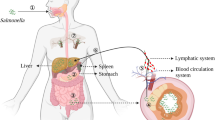Abstract
SALMONELLA infection continues to be a major world-wide health problem1. One essential pathogenic feature common to all Salmonella is their ability to penetrate the cells of the intestinal epithelium which are normally non-phagocytic2. The internalization of Salmonella into mammalian cells is thought to be a receptor-mediated phenomenon and the invasion of cultured epithelial cells depends on several Salmonella genes, but nothing is known about the host determinants participating in this interaction3–6. Protein tyrosine phosphorylation follows stimulation of many cell-surface receptors to initiate signal transduction path-ways that stimulate cellular responses7. We report here that invasion of cultured Henle-407 cells by Salmonella typhimurium induces the tyrosine phosphorylation of the epidermal growth factor (EGF) receptor. In contrast, an isogenic strain of S. typhimurium that is defective in invasion owing to a mutation in the invA gene is unable to induce such phosphorylation. Addition of EGF to cultured Henle-407 cells allowed the internalization of the invasion-defective S. typhimurium invA mutant although it did not cause the internalization of an adherent, but non-invasive, strain of Escherichia coli. This result indicates that stimulation of the EGF receptor is involved in the invasion of cultured Henle-407 cells by S. typhimurium.
Similar content being viewed by others
References
Chalker, R. B. & Blaser, M. J. Rev. infect. Dis. 10, 111–117 (1988).
Takeuchi, A. Am. J. Path. 50, 109–136 (1967).
Ginocchio, C., Pace, J. & Galán, J. E. Proc. natn. Acad. U.S.A. (in the press).
Finlay, B. B. et al. Molec. Mlcrobiol. 2, 757–766 (1988).
Elsinghorst, E. A., Baron, L. S. & Kopecko, D. J. Proc. natn. Acad. Sci. U.S.A. 86, 5173–5177 (1989).
Galán, J. E. & Curtiss III, R. Proc. natn. Acad Sci. U.S.A. 86, 6383–6387 (1989).
Ullrich, A. & Schlessinger, J. Cell 61, 203–212 (1990).
Galán, J. E., Ginocchio, C. & Costeas, P. J. Bact. (in the press).
Kadowaki, T. et al. J. biol. Chem. 261, 16141–16147 (1986).
Moolenar, W. H., Tertoolen, G. J. & de Laat, S. W. J. biol. Chem. 259, 8066–8069 (1984).
Rijken, P. J., Hage, W. J., Van Bergen En Henegouwen, P. M. P., Verkleij, A. J. & Boonstra, J. J. Cell Sci. 100, 491–499 (1991).
Cheney, C. P., Chad, P. A., Formal, S. B. & Boedecker, E. C. Infect. Immun. 28, 1019–1027 (1980).
Eppstein, D. A. et al. Nature 318, 663–665 (1985).
Todaro, G. J., Rose, T. M., Spooner, C. E., Shoyab, M. & Plowman, G. D. Sem. Cancer Biol. 1, 257–263 (1990).
Isberg, R. R. Science 252, 934–938 (1991).
Hoiseth, S. K. & Stocker, B. A. D. Nature 291, 238–239 (1981).
Kamps, M. P. & Sefton, B. M. Oncogene, 2, 305–315 (1988).
Lee, E. B. & Hayman, M. J. Oncogene. 5, 1165–1172 (1990).
Nair, N., Davis, R. J. & Robinson, H. L. Molec. cell. Biol. 12, 2010–2016 (1992).
Author information
Authors and Affiliations
Rights and permissions
About this article
Cite this article
Galán, J., Pace, J. & Hayman, M. Involvement of the epidermal growth factor receptor in the invasion of cultured mammalian cells by Salmonella typhimurium. Nature 357, 588–589 (1992). https://doi.org/10.1038/357588a0
Received:
Accepted:
Issue Date:
DOI: https://doi.org/10.1038/357588a0
- Springer Nature Limited
This article is cited by
-
Expression of active trypsin-like serine peptidases in the midgut of sugar-feeding female Anopheles aquasalis
Parasites & Vectors (2015)
-
The midgut of Aedes albopictus females expresses active trypsin-like serine peptidases
Parasites & Vectors (2014)
-
Proteolytic profiling and comparative analyses of active trypsin-like serine peptidases in preimaginal stages of Culex quinquefasciatus
Parasites & Vectors (2012)
-
Global analysis of the eukaryotic pathways and networks regulated by Salmonella typhimurium in mouse intestinal infection in vivo
BMC Genomics (2010)
-
The inflammatory cytokine tumor necrosis factor modulates the expression of Salmonella typhimurium effector proteins
Journal of Inflammation (2010)





